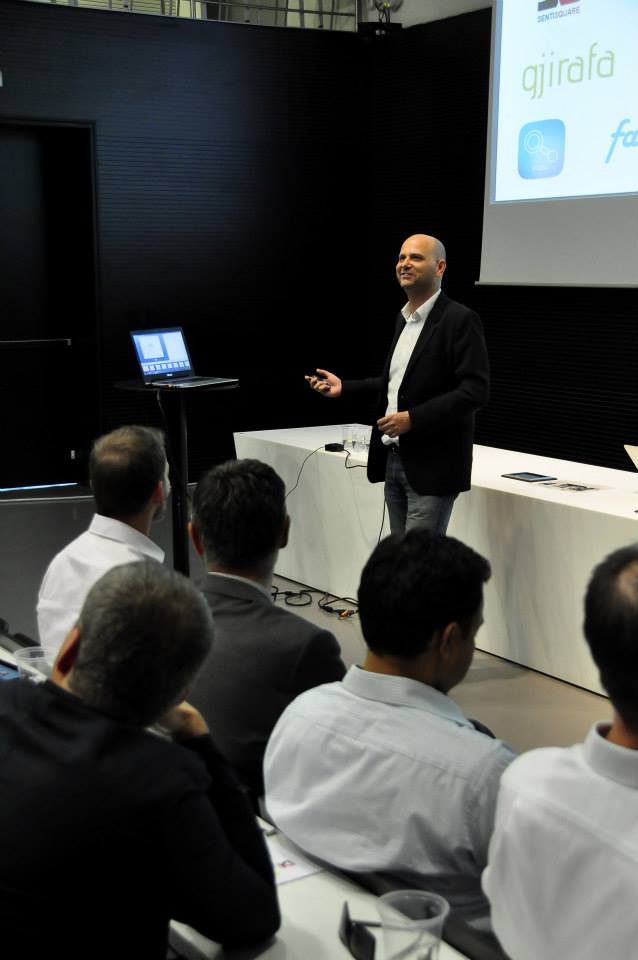Cedric Maloux: 4 Tips for Targeting Your Elevator Pitch
We’ve gone in-depth in the past about honing your pitch, crafting a position statement, and talking about your ideas in clear, relatable ways. Today we’re going to talk about what I’ll call the “Targeted Elevator Pitch.”
By the way, 20 Teams signed up in just 3 days this past week, to be a part of our Dec. 4th “Pitch-Off,” as part of the StartupYard-Node5 Accelerator Open House. Out of these, we have room for less than half, but each team will pitch for just 90 seconds, with no slides or other visual aids. If these teams can deliver a perfect Elevator Pitch, then 90 seconds should be easy.
We all know the elevator pitch of course. It’s the 30-second version of your pitch that tries to position your company with an investor, and sell them on the idea, if not the whole investment, within the space of time it takes to get from the ground floor to (hopefully) the penthouse.
You’ll deliver this version of your pitch in so many situations, and so often, that you may lose sight of its real purpose, which is not really to grow awareness of your company or your ideas, but instead to generate interest so your audience will be hungry for more and become your allies in your search for investment, partners, and other opportunities.
The problem is that it’s hard to keep in mind that different people will hear your elevator pitch in very different ways. Some people may be impressed by you and your status as an entrepreneur, while others may be having bad day, have heard too many pitches recently, or are not interested in your idea for the same reasons that others may be. Finding and exploiting the interests of your target are key to your success.
The elevator pitch is about aligning your audience to you, grabbing your audience’s attention in one sentence. How can you bring them to your level? You’ve been living/working/researching your subject for months, even years, and they have not. How can you bridge that gap in one sentence, and make sure they go from not knowing who you are, to being eager to hear what you have to say? The last thing you want to do is start blasting who you are, what you do to someone who is not fully ready to listen.
For this reason, the first sentence of your pitch should not be about you but WHY what you are about to say after is interesting/important/relevant/sensational/worth listening to. Your mission is to grab their interest in less than 5 seconds. Once you put them in that place/time where you know they are truly listening, then you can deliver your pitch efficiently. Otherwise you might as well talk to the wall. Psychology studies can help us here a lot as we’ll see.
So here are 4 keys to targeting your elevator pitch, so you’ll be sure your audience is ready to listen to you.
Create Consistency
People have a general desire to appear consistent in their behaviour. A famous set of experiments has shown that when someone is asked a hypothetical question, such as “would you consider volunteering for X cause?” No matter their initial answer, they are over 25% more likely to agree to volunteer after being asked directly, than those who are not asked the question hypothetically first.
This is commonly known as “foot in the door,” psychology, or the consistency effect. That is, if you ask someone a hypothetical question where the obvious answer is positive, then they are much more likely to answer positively when asked more direct questions.
Think about it: If someone called you and said: “Hi, do you think it’s unfair that telecom companies charge so much for data roaming in Europe?” If you’re like me, you’d say “hell yes, it’s totally unfair, and it makes me crazy.”
Now consider what would happen if someone called you and said simply: “Are you interested in getting the best data roaming rates in Europe?” :Click:
But in the first case, since you’ve already answered once with a yes, you will be much more likely to allow the salesperson who posed this question (and showed some affinity for your feelings along the way), to finish their sales pitch. You might still not buy, but you’ll feel much more inclined to listen attentively. This is the power of the consistency effect, and the building of rapport with your target. Getting a person to answer “yes,” to anything; literally to almost any question, is better than launching into a pitch directly. Saying “this traffic’s crazy… isn’t it?” Is better than nothing, and the more you can show that you share the interests of the target of your pitch; the more specific you can be in eliciting a positive response, the better.
Ask a Data Backed Question – Reach out to their logical brain
A fact is worth a 1,000 opinions, and when it comes to pitching, your audience is more likely to be interested in facts than in your opinion (who are you anyway?). For this reason, starting your pitch with strong data as an introduction is a great way to appeal to their intelligence, and make them realize that what you are about to say is big/important. A data backed question is a great way to grab their attention.
“Did you know that the worldwide mobile gaming market is going to be worth $10 Billion in two years, and that 52% of casual gamers are women?”
This has two immediate effects. First it shows your target that you do know how big a market you’re talking about, and it also shows that you may have an insight or an angle on that market that is unexploited, or has hidden potential that you can unlock.
There was a great example of this in the pitch from founder Nikola Todorovic of Warrant.ly, one of our 2014 alumni. He asked: “Did you know that X Billion dollars a year are wasted in unclaimed warrantee payouts, and that most of this money is wasted because consumers lose track of their paperwork?” That’s a very powerful question. There are potentially billions of dollars being left on the table, because the warrantee system is so broken. And that’s a prospect that is always attractive to an investor.
The Power of Because
Dr. Robert Cialdini writes in his 1984 Best-Seller Influence, the Power of Persuasion, about the power of “because.” Below is a synopsis of his position:
It’s a well-known principle of human behavior that when we ask someone to do us a favor (in our case, listening to our pitch) we will be more successful if we provide a reason. People simply respond better when given reasons to do something.
A famous set of experiments asked grad students to request that riders on the New York subway give up their seats. Students who were tasked with asking for seats for no stated reason, had minimal success, and were even drawn into verbal conflicts with the people they asked. However, when students were allowed to ask for a seat, while giving an innocuous reason for doing so: “I am tired,” “my legs hurt,” riders were overwhelmingly willing to accommodate the them.
The effectiveness of this request-plus-reason is nearly total: Ninety-four percent of people asked in a similar experiment, if someone could skip ahead of them in line for a Xerox machine “because I’m in a rush,” allowed the experimenter to skip the line. Compare this success rate to the results when the request is not justified. Under those circumstances, only 60 percent of those asked complied.
Subsequent experiments further showed that the specific reason was not as important as the specific word “because.” In fact, if the experimenter simply stated that they wished to skip the line “because I need to make copies” (which is not a justifiable reason for skipping the line to a copy machine), 93% of subjects still conceded their place in line.
So give a reason to your audience to listen to you by using the power of because. “Let me tell you about our project because….” Try to use a valid reason but remember that it does not matter as much as you might think. They now have a reason to listen to you.
These are just 3 simple tips. At the end of the day, put yourself in the shoes of the person in front of you. Is what I am saying interesting because I am saying it, or is it because I can justify its interestingness? You surely have been in a conversation where people were talking to you, and you are just day dreaming or nodding along, but not listening. The reason might be that they did not include you in the conversation: they didn’t make it about you. This leads us to our 4th tip.
Excluding To Better Include
Another way to include someone in your thinking is to actually exclude the person from something else. “I know you are not the target audience for this, but did you know that….” This intro is very powerful because the recipient mind thinks: “I’m about to learn something new here. I better listen”. We all like to learn new things and grow as smart people, so if you tell a person they don’t know something simply because they have not been looking at it, they are much more likely to listen and decide for themselves. But they have to listen to you in the first place to do that!







